Energy-Efficient Multiple Autonomous Underwater Vehicle Path Planning Scheme in Underwater Sensor Networks
Abstract
1. Introduction
2. Related Works
2.1. Energy-Efficient Protocol
2.2. AUV-Aid Technology in WUSNs
3. Analytical Model
3.1. Network and Energy Model
3.2. Charging Model
4. Path Planning of AUV
4.1. TSP Problem and Genetic Algorithm
| Algorithm 1. Pseudo-code for Genetic algorithm |
| Initialization of GA parameters (gene population size, maximum iterations, possibility of mutation, and possibility of crossover) Return: total distance and index of gene numbers //Initialize generation 0;
|
4.2. Single AUV Path-Planning
| Algorithm 2. Pseudo-code for multiple genetic algorithm |
| Initialization of MGA parameters (gene population size, maximum iterations, number of AUVs, the least distance of AUV, possibility of mutation, and possibility of crossover) |
| Return: total distance, index of gene numbers, insertion points number, and individual distance for each AUV |
|
4.3. Multiple AUV Path Planning
5. Simulation and Analysis
5.1. Parameter Setting
5.2. Effect of Iterations on Optimization Effect
5.3. Effect of Node Density
5.4. Effect of Transmitting Speed
5.5. Effect of Different Exploring Areas
6. Conclusions
Author Contributions
Funding
Data Availability Statement
Conflicts of Interest
References
- Felemban, E.; Shaikh, F.K. Underwater sensor network applications: A comprehensive survey. Int. J. Distrib. Sens. Netw. 2015, 11, 896832–896845. [Google Scholar] [CrossRef]
- Qiu, T.; Zhao, Z. Underwater Internet of Things in Smart Ocean: System Architecture and Open Issues. IEEE Trans. Ind. Inform. 2020, 16, 4297–4307. [Google Scholar] [CrossRef]
- Akyildiz, I.F.; Pompili, D. Underwater acoustic sensor networks: Research challenges. Ad Hoc Netw. 2005, 3, 257–279. [Google Scholar] [CrossRef]
- Li, Q.; Du, X. Energy-efficient data compression for underwater wireless sensor networks. IEEE Access 2020, 8, 73395–73406. [Google Scholar]
- Cheng, F.; Wang, J. Energy-efficient routing protocols in underwater wireless sensor networks: A survey. IEEE Commun. Surv. Tutor. 2014, 16, 277–294. [Google Scholar]
- Khan, A.U.; Somasundaraswaran, K. Wireless charging technologies for underwater sensor networks: A comprehensive review. IEEE Commun. Surv. Tutor. 2018, 20, 674–709. [Google Scholar]
- Pendergast, D.R.; DeMauro, E.P. A rechargeable lithium-ion battery module for underwater use. J. Power Sources 2011, 196, 793–800. [Google Scholar] [CrossRef]
- Blidberg, D.R. The development of autonomous underwater vehicles (AUV); a brief summary. In Proceedings of the IEEE ICRA, Seoul, Republic of Korea, 21–26 May 2001; Volume 4, pp. 122–129. [Google Scholar]
- Ghafoor, H.; Noh, Y. An overview of next-generation underwater target detection and tracking: An integrated underwater architecture. IEEE Access 2019, 7, 98841–98853. [Google Scholar] [CrossRef]
- Xie, L.; Shi, Y. Rechargeable sensor networks with magnetic resonant coupling. Recharg. Sens. Netw. Technol. Theory Appl. Introd. Energy Harvest. Sens. Netw. 2014, 9, 31–68. [Google Scholar]
- Lee, J.; Yun, N. A focus on comparative analysis: Key findings of MAC protocols for underwater acoustic communication according to network topology. In Proceedings of the Multimedia, Computer Graphics and Broadcasting: International Conference, Jeju Island, Korea, 8–10 December 2011. [Google Scholar]
- Zenia, N.Z.; Aseeri, M. Energy-efficiency and reliability in MAC and routing protocols for underwater wireless sensor network: A survey. J. Netw. Comput. Appl. 2016, 71, 72–85. [Google Scholar] [CrossRef]
- Khan, M.T.R.; Ahmed, S.H. An energy-efficient data collection protocol with AUV path planning in the internet of underwater things. J. Netw. Comput. Appl. 2019, 135, 20–31. [Google Scholar] [CrossRef]
- Su, Y.; Xu, Y. HCAR: A Hybrid-Coding-Aware Routing Protocol for Underwater Acoustic Sensor Networks. IEEE Internet Things J. 2023, 10, 10790–10801. [Google Scholar] [CrossRef]
- Kumar, V.; Sandeep, D. Multi-hop communication based optimal clustering in hexagon and voronoi cell structured WSNs. AEU-Int. J. Electron. Commun. 2018, 93, 305–316. [Google Scholar] [CrossRef]
- Xie, R.; Jia, X. Transmission-efficient clustering method for wireless sensor networks using compressive sensing. IEEE Trans. Parallel Distrib. Syst. 2013, 25, 806–815. [Google Scholar]
- Yadav, S.; Kumar, V. Hybrid compressive sensing enabled energy efficient transmission of multi-hop clustered UWSNs. AEU-Int. J. Electron. Commun. 2019, 110, 152836–152851. [Google Scholar] [CrossRef]
- Sun, Y.; Zheng, M.; Han, X.; Li, S.; Yin, J. Adaptive clustering routing protocol for underwater sensor networks. Ad Hoc Netw. 2022, 136, 102953–102965. [Google Scholar] [CrossRef]
- Fan, R.; Jin, Z. A time-varying acoustic channel-aware topology control mechanism for cooperative underwater sonar detection network. Ad Hoc Netw. 2023, 149, 103228. [Google Scholar] [CrossRef]
- Liu, C.F.; Zhao, Z. A distributed node deployment algorithm for underwater wireless sensor networks based on virtual forces. J. Syst. Archit. 2019, 97, 9–19. [Google Scholar] [CrossRef]
- Wei, L.; Han, J. Topology Control Algorithm of Underwater Sensor Network Based on Potential-Game and Optimal Rigid Sub-Graph. IEEE Access 2020, 8, 177481–177494. [Google Scholar] [CrossRef]
- Zhu, R.; Boukerche, A. A trust management-based secure routing protocol with AUV-aided path repairing for Underwater Acoustic Sensor Networks. Ad Hoc Netw. 2023, 149, 103212–103225. [Google Scholar] [CrossRef]
- Yan, Z.; Li, Y. Data collection optimization of ocean observation network based on AUV path planning and communication. Ocean Eng. 2023, 282, 114912–114927. [Google Scholar] [CrossRef]
- Shen, G.; Zhu, X. Research on phase combination and signal timing based on improved K-medoids algorithm for intersection signal control. Wirel. Commun. Mob. Comput. 2020, 2020, 3240675. [Google Scholar] [CrossRef]
- Yan, Z.; Zhang, J. Three-dimensional path planning for autonomous underwater vehicles based on a whale optimization algorithm. Ocean Eng. 2022, 250, 111070–111087. [Google Scholar] [CrossRef]
- Gjanci, P.; Petrioli, C. Path finding for maximum value of information in multi-modal underwater wireless sensor networks. IEEE Trans. Mob. Comput. 2017, 17, 404–418. [Google Scholar] [CrossRef]
- Yan, J.; Yang, X. Energy-efficient data collection over AUV-assisted underwater acoustic sensor network. IEEE Syst. J. 2018, 12, 3519–3530. [Google Scholar] [CrossRef]
- Kan, T.; Mai, R. Design and analysis of a Three-Phase wireless charging system for lightweight autonomous underwater vehicles. IEEE Trans. Power Electron. 2018, 33, 6622–6632. [Google Scholar] [CrossRef]
- Ramos, A.G.; García-Garrido, V.J. Lagrangian coherent structure assisted path planning for transoceanic autonomous underwater vehicle missions. Sci. Rep. 2018, 8, 4575. [Google Scholar] [CrossRef]
- Cheng, C.; Sha, Q. Path planning and obstacle avoidance for AUV: A review. Ocean Eng. 2021, 235, 109355–109368. [Google Scholar] [CrossRef]
- Kumar, S.V.; Jayaparvathy, R. Efficient path planning of AUVs for container ship oil spill detection in coastal areas. Ocean Eng. 2020, 217, 107932–107945. [Google Scholar] [CrossRef]
- Golen, E.; Mishra, F. An underwater sensor allocation scheme for a range dependent environment. Comput. Netw. 2010, 54, 404–415. [Google Scholar] [CrossRef]
- Yi, Y.; Yang, G.S. Energy balancing and path plan strategy for rechargeable underwater sensor network. In Proceedings of the 2022-4th International Conference on Advances in Computer Technology, Suzhou, China, 22–24 April 2022. [Google Scholar]
- Chen, Y.; Lin, Y. Mobicast routing protocol for underwater sensor networks. IEEE Sens. J. 2012, 13, 737–749. [Google Scholar] [CrossRef]
- Liu, Y.; Dong, M. Active Trust: Secure and trustable routing in wireless sensor networks. IEEE Trans. 2017, 11, 2013–2027. [Google Scholar]
- Gao, X.; Chen, Z. Energy efficient algorithms for k-sink minimum movement target coverage problem in mobile sensor network. IEEE Trans. 2017, 25, 3616–3627. [Google Scholar] [CrossRef]
- Benson, B.; Li, Y. Design of a Low-Cost, Underwater Acoustic Modem for Short-Range Sensor Networks; IEEE: Piscataway, NJ, USA, 2010; pp. 1–9. [Google Scholar]
- Heidemann, J.; Stojanovic, M. Underwater sensor networks: Applications, advances and challenges. Philos. Trans. R. Soc. 2011, 370, 1–20. [Google Scholar] [CrossRef] [PubMed]
- Islam, K.Y.; Ahmad, I. A survey on energy efficiency in underwater wireless communications. J. Netw. Comput. Appl. 2022, 198, 103295–103325. [Google Scholar] [CrossRef]
- Domingo, M.C.; Prior, R. Energy analysis of routing protocols for underwater wireless sensor networks. Comput. Commun. 2008, 31, 1227–1238. [Google Scholar] [CrossRef]
- De Carolis, V.; Lane, D.M. Low-cost energy measurement and estimation for autonomous underwater vehicles. In Proceedings of the Oceans 2014-Taipei, Taipei, Taiwan, 7–10 April 2014; pp. 1–5. [Google Scholar]
- Guo, Y.J.; Meng, Q.L. Research status and prospect of AUV path planning algorithms. J. Front. Comput. Sci. Technol. 2020, 14, 1981–1994. [Google Scholar]
- Hao, K.; Zhao, J. Dynamic path planning of a three-dimensional underwater AUV based on an adaptive genetic algorithm. Ocean Eng. 2022, 263, 112421–112442. [Google Scholar] [CrossRef]
- Kato, N.; Choyekh, M. An autonomous underwater robot for tracking and monitoring of subsea plumes after oil spills and gas leaks from seafloor. J. Loss Prev. Process Ind. 2017, 50, 386–396. [Google Scholar] [CrossRef]
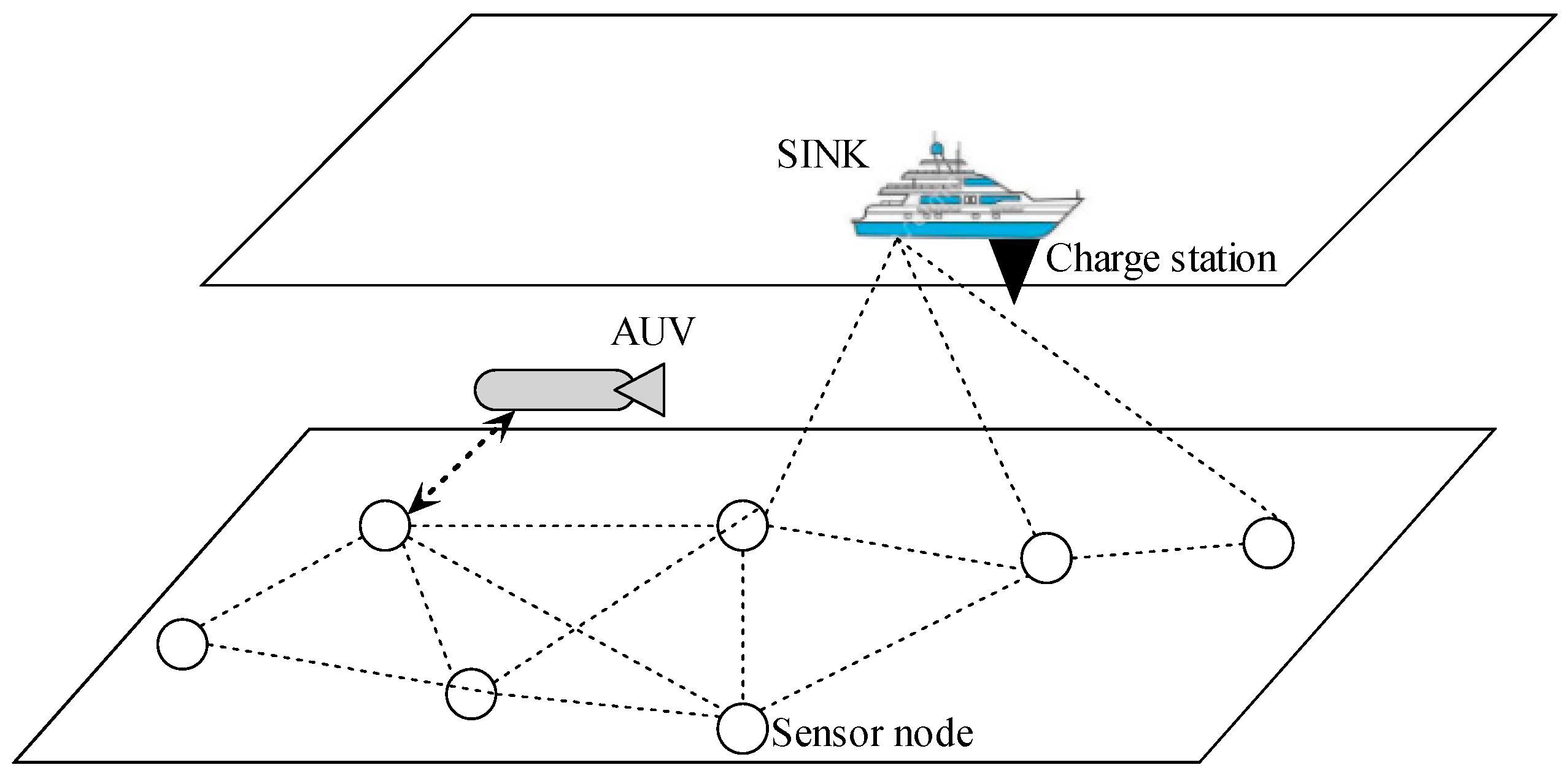


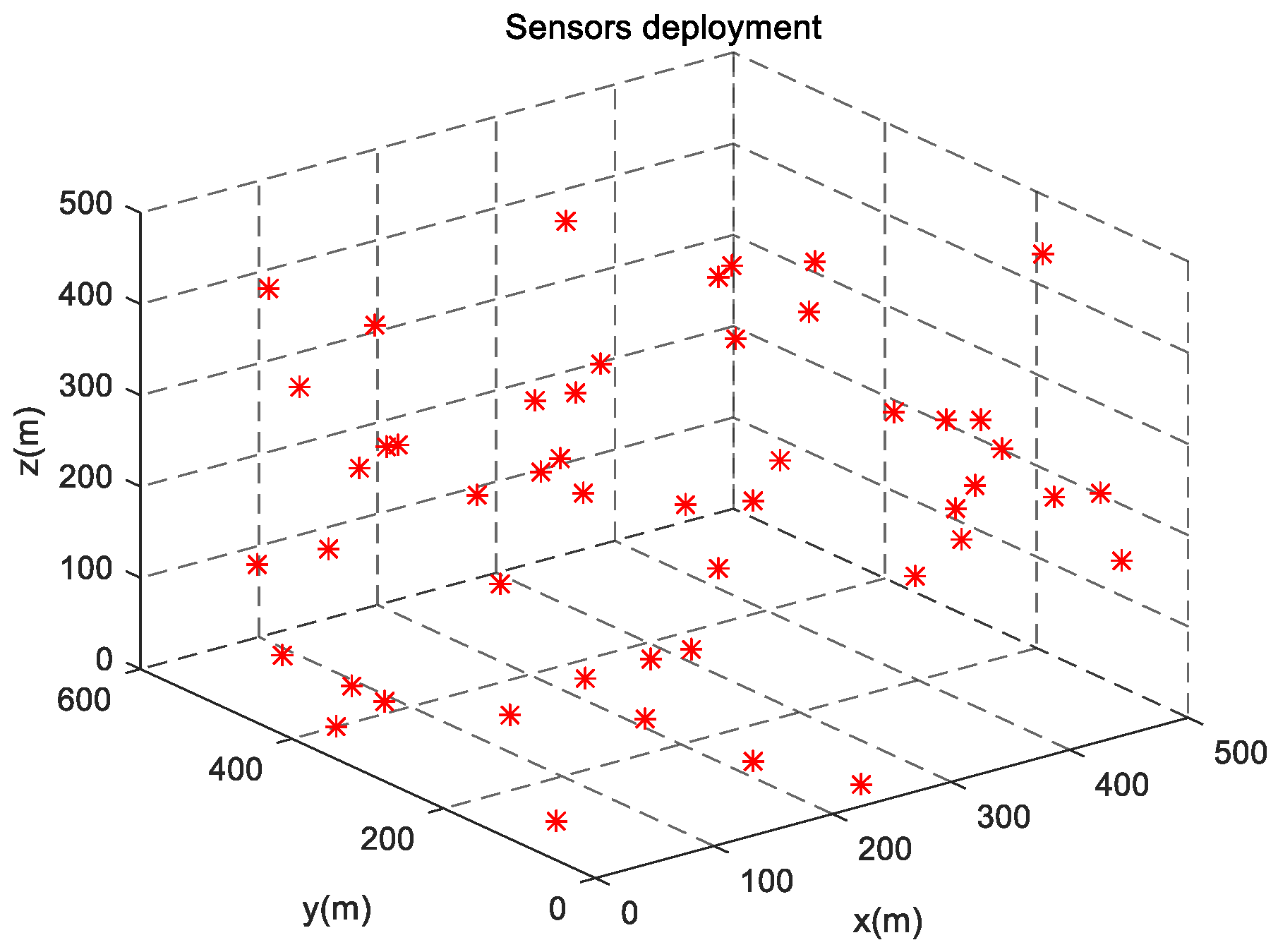

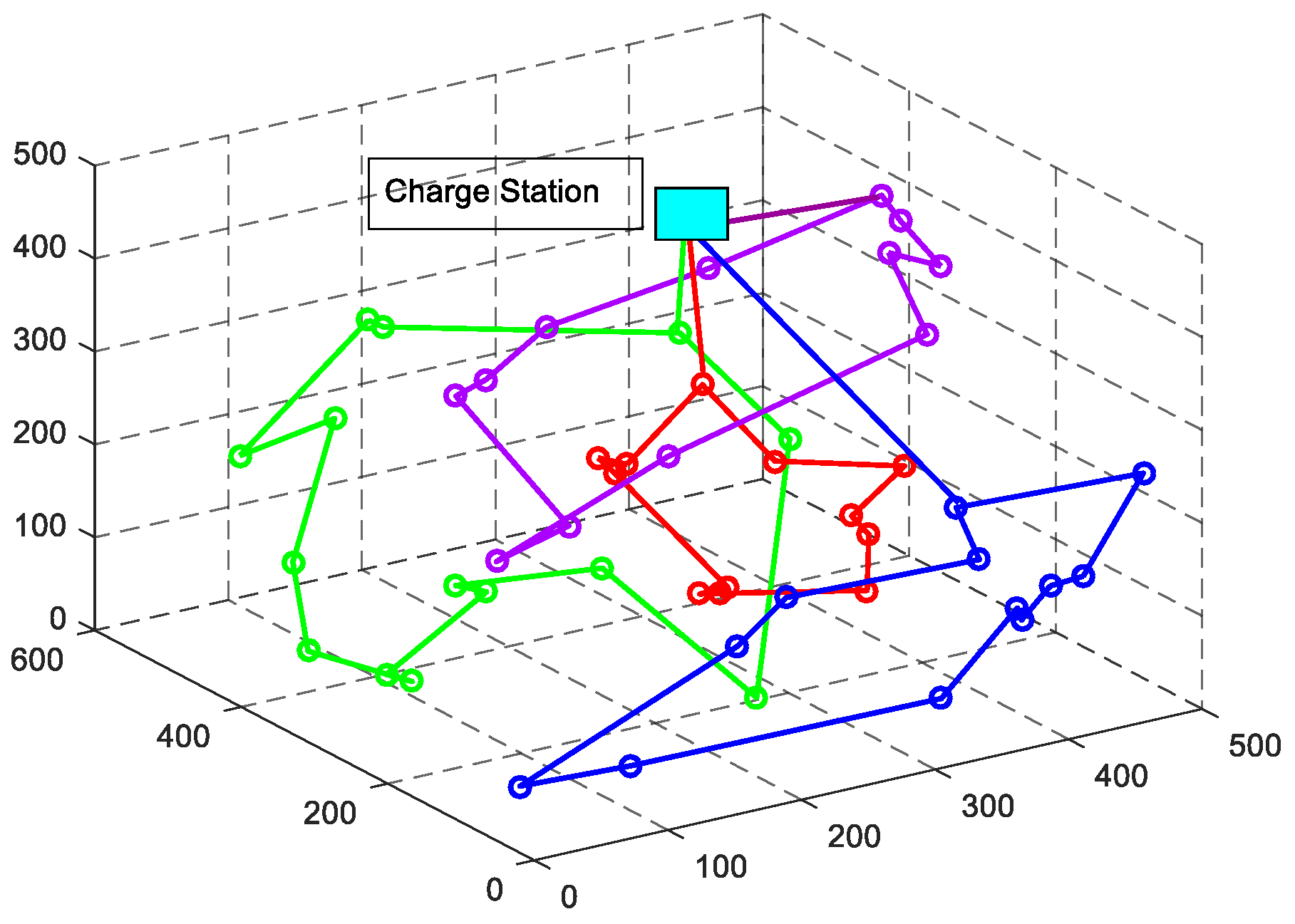
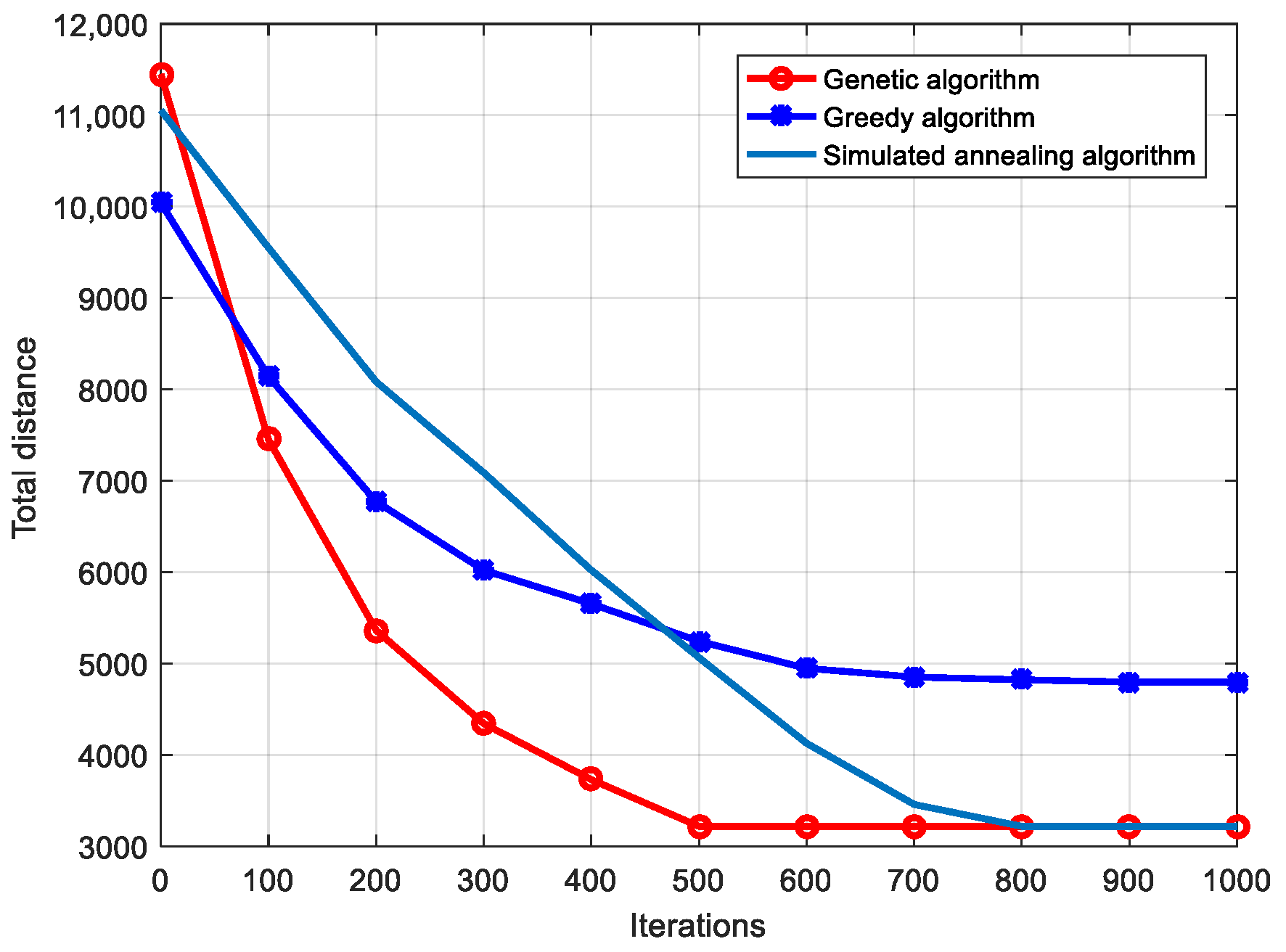
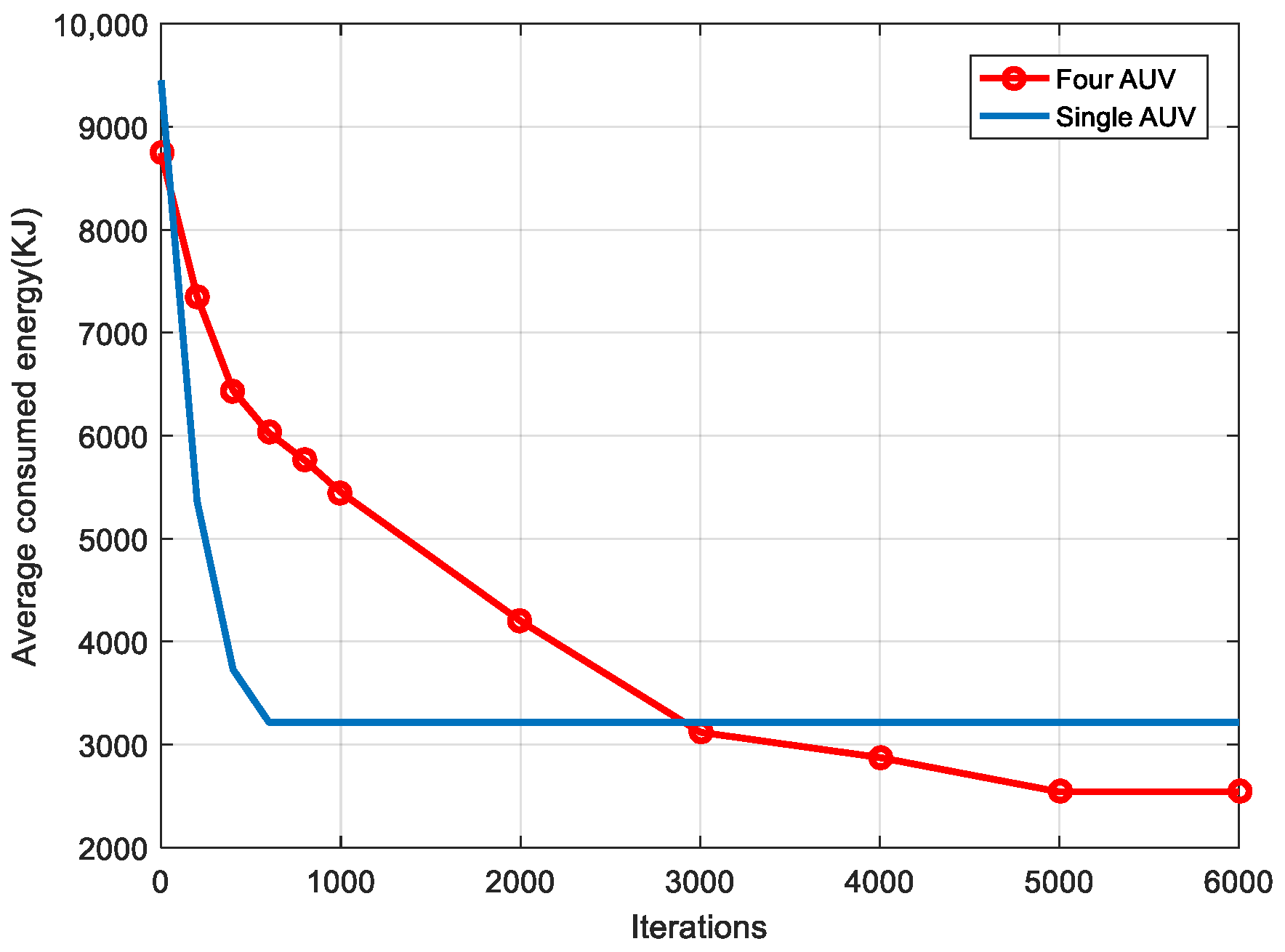

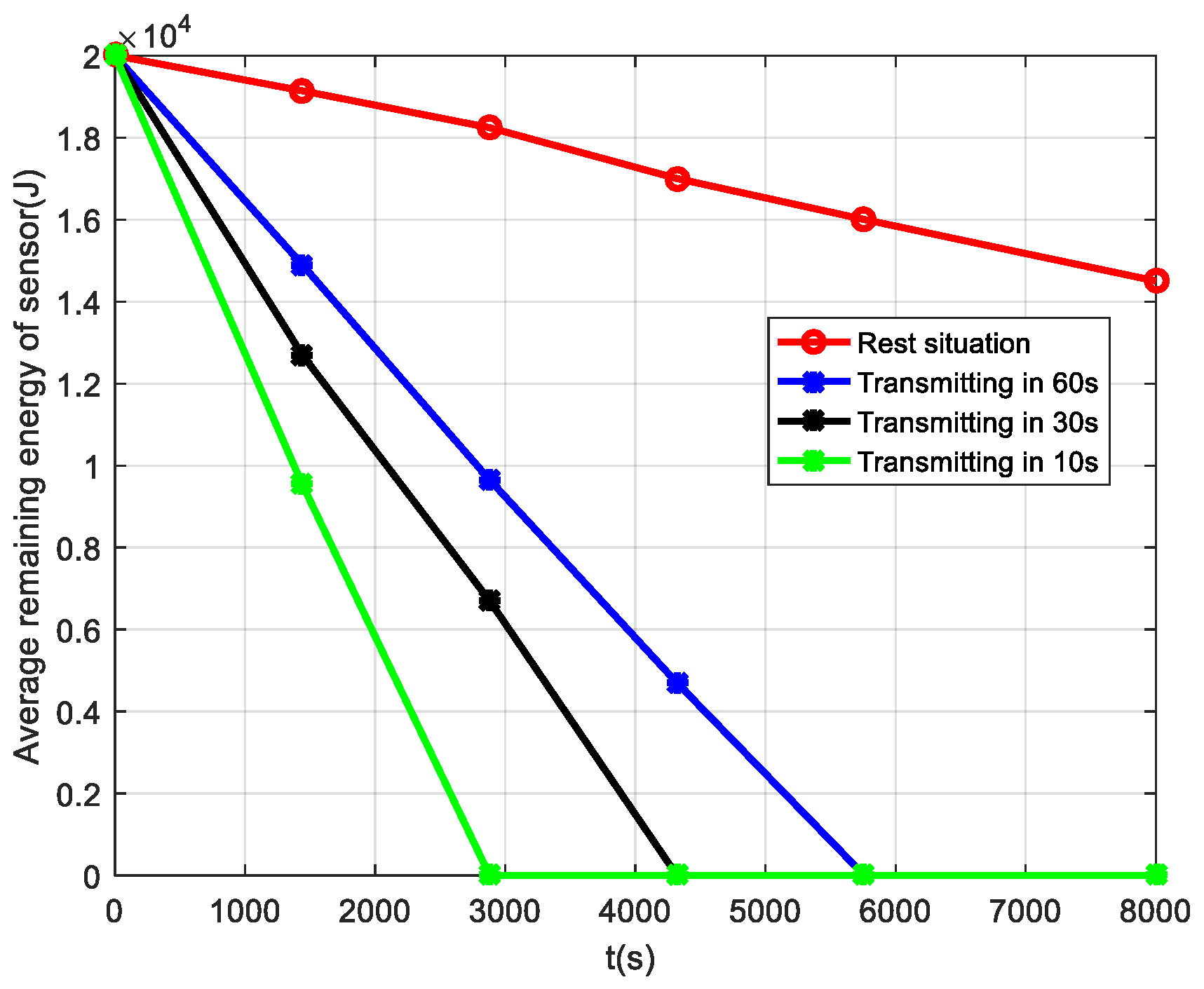

| Convergence Speed | Error Rates | Optimization Effect | |
|---|---|---|---|
| Greedy algorithm | Faster speed | 20% |
|
| Simulated annealing algorithm | Slower speed | 5% |
|
| Genetic Algorithms | Average speed | 3% |
|
| Symbol | Description | Value |
|---|---|---|
| Maximum volume of sensor battery | 3600 s × 2.5 V × 2.4 A = 21.6 KJ | |
| The minimum volume of sensor battery | 0.05 × Emax = 1.08 KJ | |
| The speed of AUV | 3 nm/h = 5.562 km/h | |
| Frequency | 10 (kHz) | |
| Frequency factor in underwater | / | |
| Energy consumption rate of a data unit sent by node i to node j | / | |
| Energy consumption rate of each sensor node | / | |
| the energy consumption factor for receiving data. | 50 NJ/b | |
| The coefficient value of AUV on x axis | 557.24 J/m | |
| The coefficient value of AUV on y axis | 1174.21 J/m | |
| The coefficient value of AUV on z axis | 1354.16 J/m | |
| Idle power | 30 mW | |
| Transmission power (0.5 km) | 20–40 W | |
| Receiving power | 3 W | |
| Total time cost by AUV | / | |
| Traveling time cost by AUV | / | |
| Charging efficiency | / |
Disclaimer/Publisher’s Note: The statements, opinions and data contained in all publications are solely those of the individual author(s) and contributor(s) and not of MDPI and/or the editor(s). MDPI and/or the editor(s) disclaim responsibility for any injury to people or property resulting from any ideas, methods, instructions or products referred to in the content. |
© 2023 by the authors. Licensee MDPI, Basel, Switzerland. This article is an open access article distributed under the terms and conditions of the Creative Commons Attribution (CC BY) license (https://creativecommons.org/licenses/by/4.0/).
Share and Cite
Cui, Y.; Zhu, P.; Lei, G.; Chen, P.; Yang, G. Energy-Efficient Multiple Autonomous Underwater Vehicle Path Planning Scheme in Underwater Sensor Networks. Electronics 2023, 12, 3321. https://doi.org/10.3390/electronics12153321
Cui Y, Zhu P, Lei G, Chen P, Yang G. Energy-Efficient Multiple Autonomous Underwater Vehicle Path Planning Scheme in Underwater Sensor Networks. Electronics. 2023; 12(15):3321. https://doi.org/10.3390/electronics12153321
Chicago/Turabian StyleCui, Yangfan, Peibin Zhu, Guowei Lei, Peng Chen, and Guangsong Yang. 2023. "Energy-Efficient Multiple Autonomous Underwater Vehicle Path Planning Scheme in Underwater Sensor Networks" Electronics 12, no. 15: 3321. https://doi.org/10.3390/electronics12153321
APA StyleCui, Y., Zhu, P., Lei, G., Chen, P., & Yang, G. (2023). Energy-Efficient Multiple Autonomous Underwater Vehicle Path Planning Scheme in Underwater Sensor Networks. Electronics, 12(15), 3321. https://doi.org/10.3390/electronics12153321










